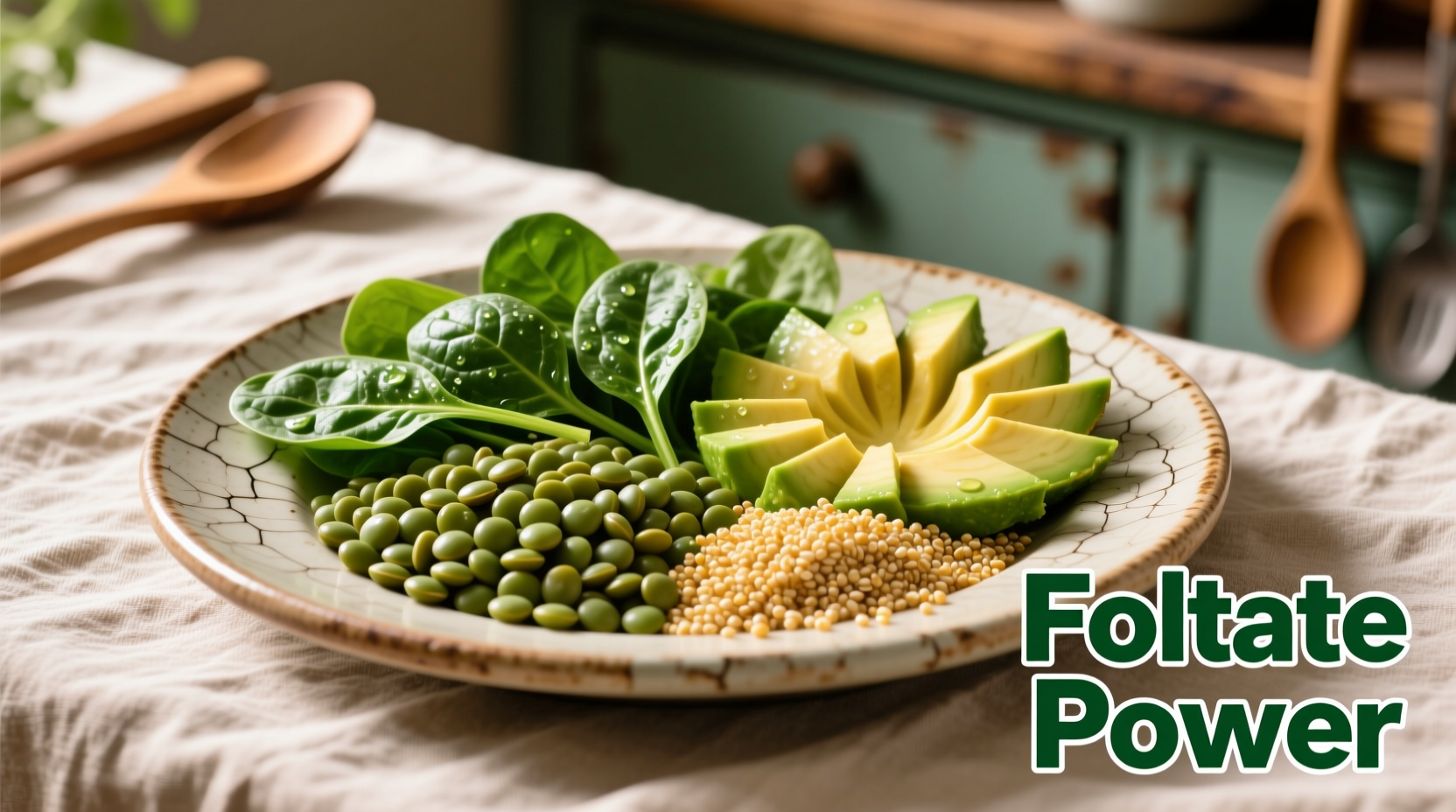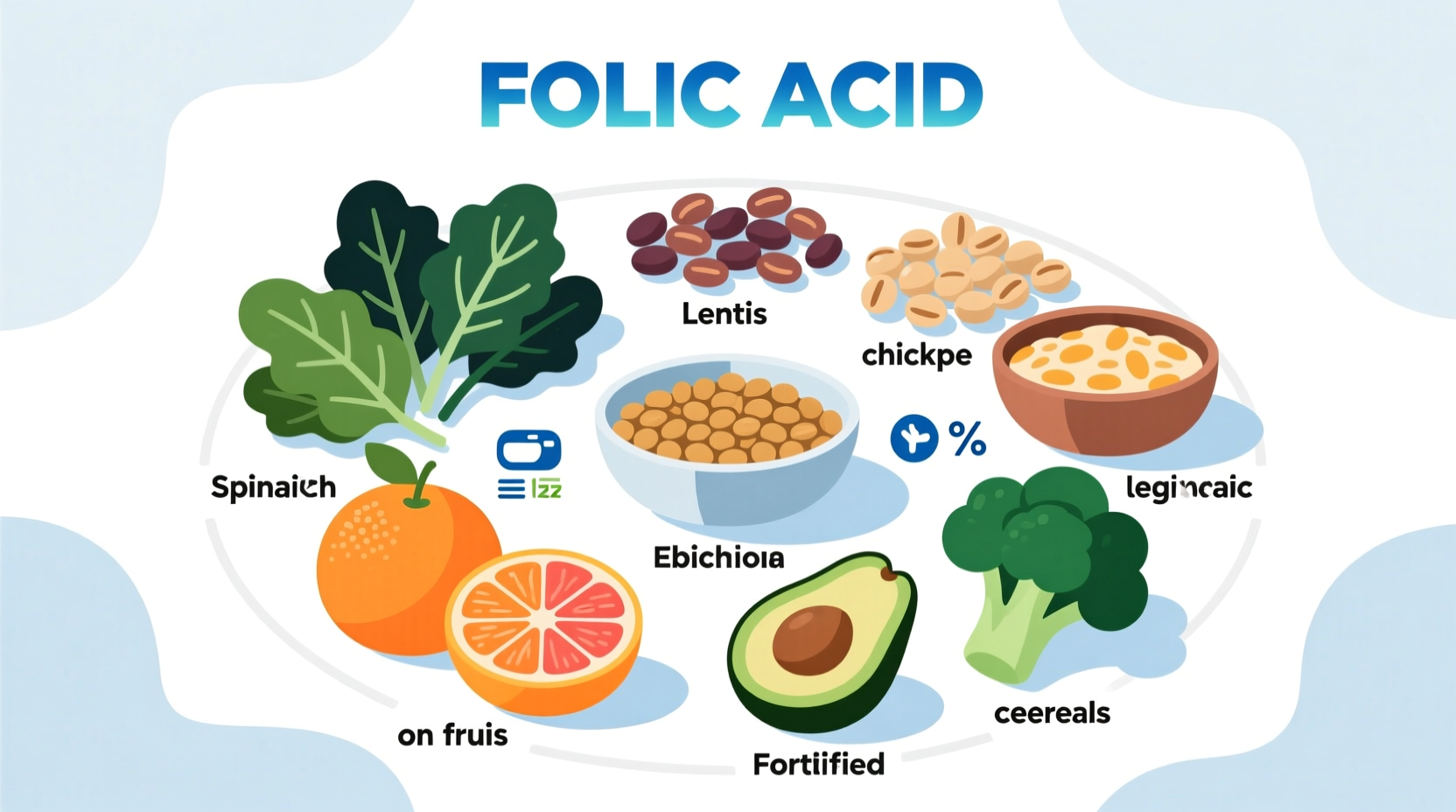The top natural food sources of folic acid (folate) include cooked lentils (358 mcg per cup), cooked spinach (263 mcg per cup), black-eyed peas (210 mcg per cup), asparagus (134 mcg per 4 spears), and avocado (59 mcg per half). Just one cup of cooked lentils provides nearly 90% of the recommended daily value of 400 mcg for most adults. These whole food sources offer the natural folate form that your body processes efficiently.
When you're searching for what foods are high in folic acid, you're likely looking for reliable, science-backed options to support your health goals. Whether you're planning a pregnancy, managing a nutritional deficiency, or simply aiming to improve your diet, understanding which foods deliver the most folate—the natural form found in foods—is crucial. Unlike synthetic folic acid in supplements, folate from whole foods comes packaged with other nutrients that enhance absorption and utilization.
Why Folic Acid Matters: More Than Just Pregnancy Nutrition
Folic acid (vitamin B9) plays a vital role in DNA synthesis, red blood cell formation, and preventing neural tube defects during early pregnancy. But its importance extends far beyond pregnancy. Research shows adequate folate intake supports cardiovascular health by helping regulate homocysteine levels, boosts cognitive function, and may reduce depression risk.
Key Milestones in Folic Acid Understanding
- 1931: Dr. Lucy Wills discovers a nutritional factor in yeast that prevents anemia in pregnant women
- 1941: Researchers isolate and name this compound "folic acid" from spinach leaves
- 1991: Landmark study shows folic acid supplementation reduces neural tube defects by 72%
- 1998: U.S. mandates folic acid fortification of enriched grain products
- 2020s: Research expands to show folate's role in cognitive health and cardiovascular protection
Top Food Sources of Folate: Your Complete Guide
While supplements provide synthetic folic acid, whole foods deliver natural folate along with complementary nutrients. Here's what the latest USDA FoodData Central database reveals about the most folate-rich options:
| Food (1 cup unless noted) | Folate Content (mcg) | % Daily Value | Best Preparation Method |
|---|---|---|---|
| Cooked lentils | 358 | 89% | Simmer with garlic and lemon |
| Cooked spinach (1/2 cup) | 131 | 33% | Sauté with olive oil |
| Black-eyed peas | 210 | 52% | Simmer with onions and spices |
| Asparagus (4 spears) | 89 | 22% | Roast or grill |
| Avocado (1/2 medium) | 59 | 15% | Raw in salads or toast |
| Romaine lettuce (2 cups) | 64 | 16% | Raw in salads |
| Broccoli (1/2 cup) | 52 | 13% | Steam or roast |
Maximizing Folate Absorption: What Most Guides Don't Tell You
Not all folate-rich foods deliver equal benefits. Understanding these context boundaries significantly impacts how much nutritional value you actually receive:
- Raw vs. Cooked: Light cooking actually increases folate bioavailability in leafy greens like spinach by breaking down cell walls, but overcooking destroys the vitamin
- Vitamin C pairing: Consuming folate-rich foods with vitamin C sources (like citrus or bell peppers) can boost absorption by up to 30%
- Avoid alcohol with meals: Even moderate alcohol consumption can reduce folate absorption by 20-30%
- Processing matters: Canned beans retain about 70% of their folate compared to freshly cooked, while frozen vegetables maintain nearly 100% when properly stored

Folate Needs Across Life Stages
Your requirements for folate-rich foods change throughout life. The National Institutes of Health recommends:
- Adults: 400 mcg DFE (Dietary Folate Equivalents) daily
- Pregnant women: 600 mcg DFE (critical for neural tube development in first 28 days)
- Breastfeeding women: 500 mcg DFE
- Older adults: 400 mcg DFE (higher risk of deficiency due to reduced absorption)
For those searching for best foods high in folate for pregnancy, focus on incorporating at least three servings daily from the top sources. One practical approach: add a half-cup of cooked lentils to your lunch salad, snack on an avocado, and include asparagus with dinner.
Practical Integration: Making Folate-Rich Eating Sustainable
Instead of drastic diet changes, try these chef-tested techniques for naturally increasing your folate intake:
- Monday Meal Prep: Cook a batch of lentils to add to salads, soups, and grain bowls throughout the week
- Smoothie Boost: Add a handful of spinach to fruit smoothies (the sweetness masks any bitterness)
- Egg Enhancement: Top avocado toast with a fried egg and microgreens for a folate-rich breakfast
- Bean Rotation: Alternate between black-eyed peas, chickpeas, and lentils to maintain variety and maximize nutrient intake
When selecting ingredients for foods rich in folic acid for vegetarians, remember that plant-based sources provide natural folate that's highly bioavailable when properly prepared. The key is consistency—small daily additions create significant nutritional impact over time.
Frequently Asked Questions
Can you get enough folate from food alone without supplements?
Yes, most healthy adults can meet their folate needs through diet alone by consistently consuming folate-rich foods like lentils, leafy greens, and asparagus. However, women who are pregnant or planning pregnancy often require supplementation in addition to dietary sources to reach the recommended 600 mcg DFE daily, as neural tube development requires precise timing that food sources alone may not reliably provide.
What's the difference between folic acid and folate?
Folate refers to the natural form of vitamin B9 found in foods, while folic acid is the synthetic form used in supplements and fortified foods. Your body processes folate more efficiently than folic acid, and some people have genetic variations (MTHFR gene) that make it difficult to convert folic acid to the active form. Whole food sources provide folate along with other nutrients that enhance its utilization.
Which cooking methods preserve the most folate in vegetables?
Steaming and quick stir-frying preserve the most folate, as water-soluble vitamins leach into cooking water during boiling. For leafy greens like spinach, light cooking actually increases folate bioavailability by breaking down cell walls, but should be limited to 3-5 minutes. Roasting works well for asparagus and broccoli. When boiling is necessary, save the cooking liquid for soups or sauces to retain nutrients.
How quickly can you correct a folate deficiency through diet?
Dietary correction of mild folate deficiency typically shows improvement in blood levels within 4-6 weeks when consistently consuming 600-800 mcg of dietary folate daily. However, severe deficiencies often require medical supervision and supplementation initially, followed by dietary maintenance. Blood tests are the only reliable way to monitor progress, as symptoms like fatigue and irritability are non-specific.
Are there any risks to consuming too much folate from food sources?
No, there are no documented risks from consuming high amounts of natural folate from whole foods. The upper limit concern (1,000 mcg) applies only to synthetic folic acid from supplements and fortified foods, which can mask vitamin B12 deficiency symptoms if consumed in excess. Food sources provide folate in balanced amounts alongside other nutrients that support proper metabolism.











 浙公网安备
33010002000092号
浙公网安备
33010002000092号 浙B2-20120091-4
浙B2-20120091-4